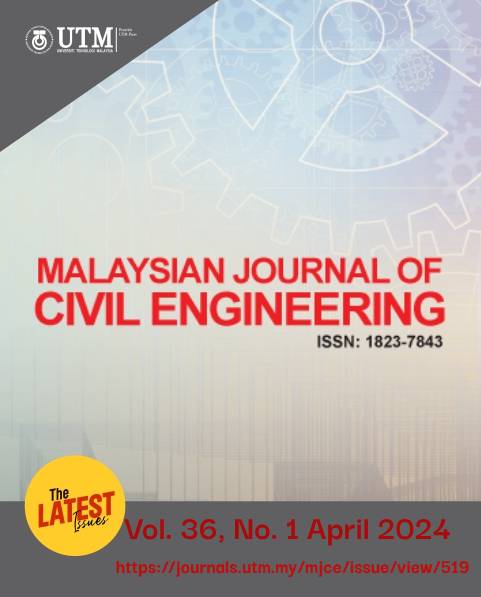IDENTIFICATION OF ACCIDENT LOCATION AND DEGREE OF VULNERABILITY ALONG OSOGBO-GBONGAN ROAD, OSUN STATE, NIGERIA
DOI:
https://doi.org/10.11113/mjce.v36.20995Keywords:
RTAs, T.SPWEG-AV Index, Blackspot, Minor, FatalAbstract
Road traffic accidents (RTAs) remain a significant global concern and leading cause of death of people within the economically active age-group in developing countries thereby mounting negative effect on people’s health, economy and the society at large. This research aimed at developing a prediction model for accident prone areas along Osogbo-Gbongan road as past studies revealed that the study area reported the highest RTAs in Osun State, Nigeria. Four years accident data obtained from FRSC, Osogbo Branch was characterized in terms of casualty, accident causes and location and affected age-groups (Adult/Children). Geometric parameters were obtained onsite by physical measurement to estimate the vulnerability of the road at blackspot locations. The identified accident blackspots were Ogo-oluwa (02+000), Ataoja (04+000), Abeere (06+000), Owode (10+000) and Akoda (15+000) with their vulnerability indices as 53, 67, 78, 66 and 70, respectively. The obtained total occurrence of accidents in 2018, 2019, 2020 and 2021 were 144, 128, 168 and 313, respectively with speed violation as the highest causative factor. Abeere Area has the highest accident occurrence of 31 and the highest T.SPWEG-A.V.I of 78 with three other locations showing similar pattern except Owode Area. Therefore, this model showed a perfect correlation of 80% thereby ensuring the validity of the model for predicting the accident vulnerability at accident locations. This study concluded that accident in this area can be characterized as minor, serious and fatal with the fatal causing deaths. The speed violation and poor road geometry were the primary factors contributing to the severity of accident and it will continue to increase if urgent intervention is not applied. The study recommended that speed law should be enforced, presence of safety personnel at the noon part of the day and those in charge of road design, supervision and construction should uphold good practice and rehabilitate the existing road geometry so as to curtail accident reoccurrence along the study area.
References
Aderinlewo, O.O. and Afolayan, A. 2019. Development of Road Accident Prediction Models for Akure-Owo Highway, Ondo State, Nigeria. Journal of Engineering Science, 15(2): 53-70.
Aderinola, O.S. Laoye, A.A., and Nnochiri, E.S. 2017. A Parametric Model for Accident Prediction along Akure-Owo Road, Ondo State, Nigeria. IOSR Journal of Mechanical and Civil Engineering, 32-40.
Afolabi, J.A., and Gbadamosi, K.T. 2017. Road Traffic Crashes in Nigeria: Causes and Consequences. Transport and Logistic: The International Journal, 17(42): 40-49.
Antonio, L., Sara, F., Isabel, I., and Antonio, C. 2019. Urban Road Crashes and Weather Conditions: Untangling the Effect. Sustainability, 11(11): 3176.
Ayodeji, I. 2018. Inter-Group Disparities in Fatal Road Traffic Accident in Texas. European Scientific Journal, 14(17): 6179.
Hasibul I.M., Law T.H., Hamid H., and Arash A. 2019. Relationship of Accident Rates and Road Geometric Design. Earth and Environmental Science, 1-10.
Katerina, B., Eva, M., Robert, Z., Pavlina, M., Martina, K. and Roman, M. 2020. Human Factors Contributing to the Road Traffic Accident Occurrence. Transportation Research Procedia, 555-561.
Muthusamy, A.P., Rajendran, M., Ramesh, K. and Sivaprakash, P. 2015. A Review on Road Traffic Accident and Related Factors. International Journal of Applied Engineering Research, 10(11): 28177-28183.
Oluwayemi, A.A., Yinusa, O.D. and Lukman, O.O. 2020. Economic Growth, Motorisation and Road Traffic Safety in Nigeria. Ilorin Journal of Economic Policy, 7: 16-34.
Ozor, P.A., and Ozoegwu, C.G. 2020. Comparison of Multiple Linear and Quadratic Model in Estimating Road Crashes in Semi-Urban Two-Lane Road: Case Study of Nsukka Municipal Council, South Eastern Nigeria. Arid Zone Journal of Engineering, Technology and Environment, 16(4):637-650.
Rejoice, B., Amit, A., and Laxmansinh, Z. 2020. Development of Model for Road Crashes and Identification of Accident Spots. International Journal of Intelligent Transportation Systems Research, 19: 99-111.
Thakali, L., Kwon, T.J., Fu, L. 2015. Identification of crash hotspots using kernel density estimation and kriging methods: a comparison. Journal of Modern Transportation, 23(2):93–106. DOI 10.1007/s40534-015-0068-0.
Wilson, N, Akinola, S.O., and Kingsley, E.U. 2019. The Urban Traffic Congestion Problem In Benin City And The Search For An ICT-Improved Solution. International Journal of Scientific and Technology Research, 8(12): 56-72.
Yousef, S., Gholamali, S., and Morteza B. 2019. Hotspot Location Identification Using Accident Data, Traffic and Geometric Characteristics. Engineering Journal, 23(6): 191-207.
















